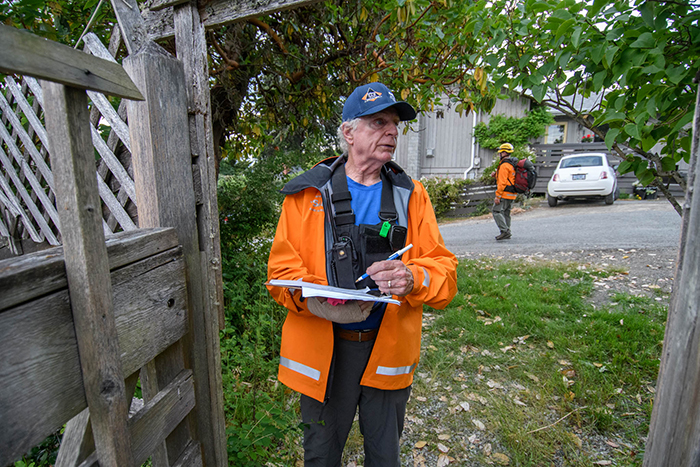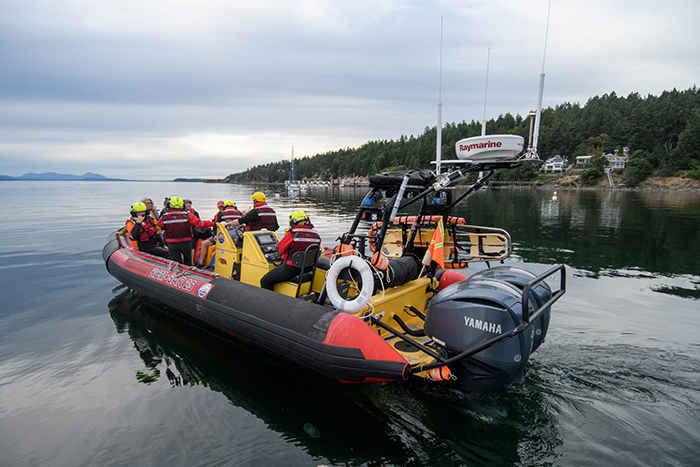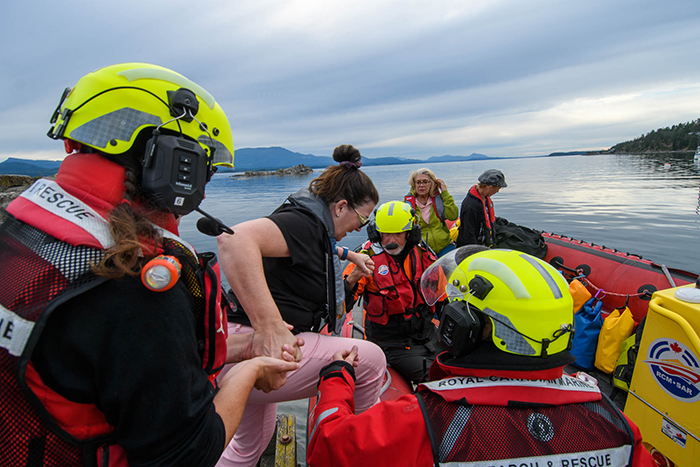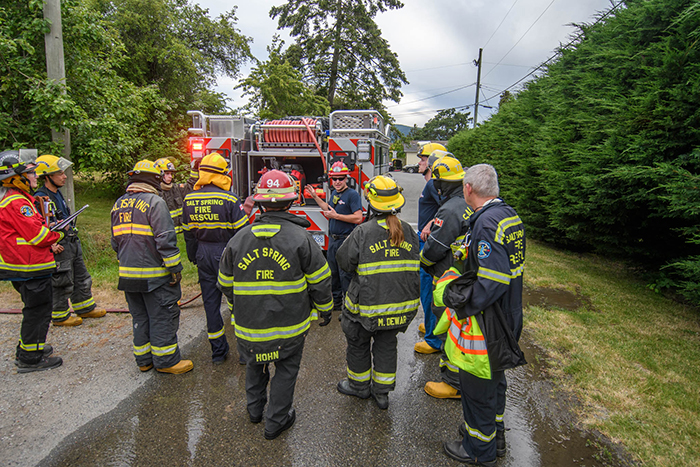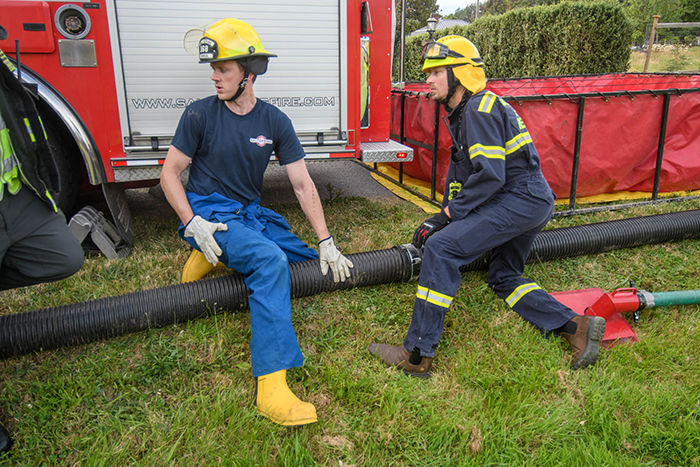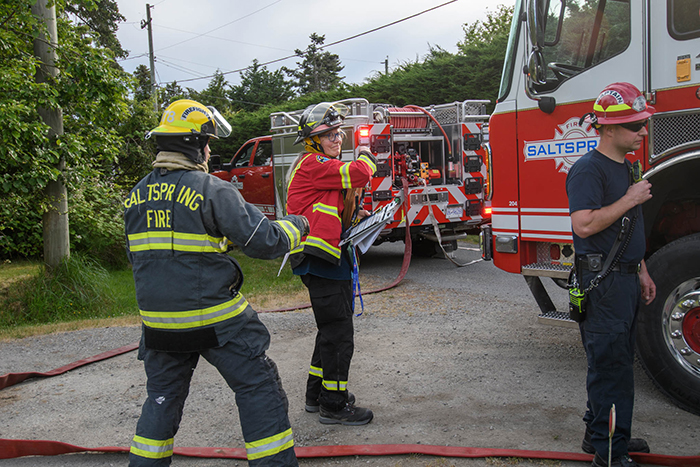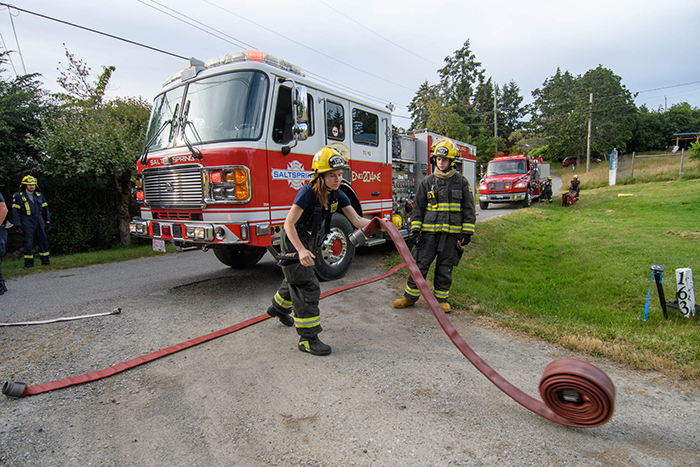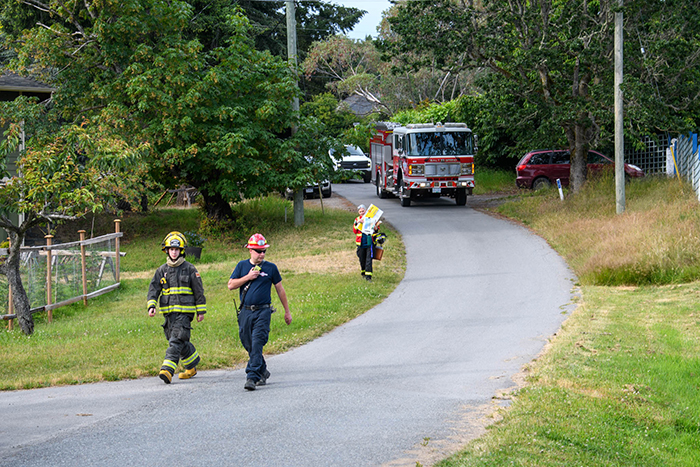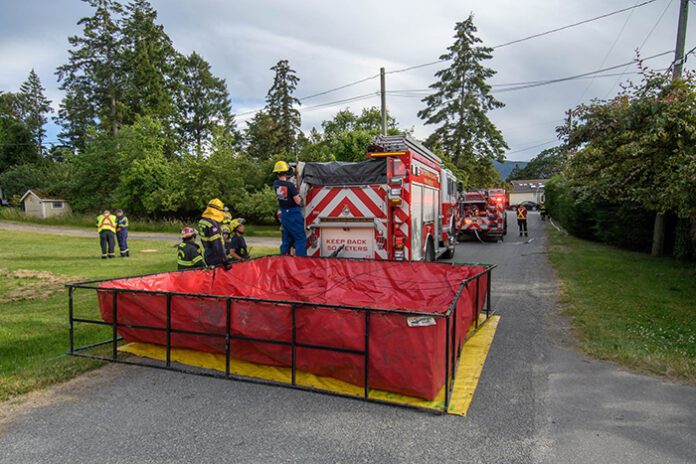Story by Carol Volkart
Photos by John Denniston
The fire was fictional, but its lessons were real.
When first responders descended on Vesuvius in a surge of fire trucks, flashing red lights and rescue gear the evening of June 25, they were part of an Emergency Program exercise aimed at preparing Salt Springers – civilians and emergency workers alike – for a disaster that could happen any day.
The goal was to discover what could be learned from a dramatic – if imaginary – fire in a residential waterfront neighbourhood like Vesuvius. How would agencies work together? How would residents be warned and, if necessary, evacuated? How would missing people be searched for? What services, and where, would be offered to victims?
“We know preparation is key,” said Emergency Management lead John Wakefield, whose organization coordinates about four simulated disasters — such as windstorms, wildfires and tsunamis — every year. “When residents know how to take care of themselves and first responder agencies know how to work together, we’ll have far better outcomes when disasters happen.”
Because it’s wildfire season, the scenario for the latest exercise was a vehicle fire at Tantramar and Bayview that spread through the treetops to cover six hectares. Ground Search and Rescue crews had the job of knocking on doors to warn residents and ensuring they knew where to go. Marine Search and Rescue crews plucked four pre-selected “evacuees” off a private dock and took them across the bay to a wharf at the ferry terminal, then searched along the coastline for others reported missing. A BC Transit bus took the evacuees to a reception centre at the Community Gospel Chapel, where Emergency Support Services (ESS) helped them register for assistance.
Many aspects of the scenario went smoothly, but there were the inevitable challenges. The first happened shortly after fire crews parked their trucks on Bayview, which was supposedly closed at the intersection with Goodrich. An SUV bearing residents who had just arrived from off-island needed to get past, and had to be carefully guided alongside Salt Spring Fire Rescue crews busy with gauges, hoses and a giant water storage tank set up on the road.
Speaking a few days after the event, Wakefield said a full debriefing will explore what lessons can be learned. But his initial impression was that while the marine and bus transfer parts of the operation went smoothly, there appeared to be issues around the evacuation process, as well as with communications and technology. “The incident command structure – who is controlling what and how people are working together — are the critical pieces when you have a number of agencies working together.”
Wakefield acknowledged that it’s difficult to make an imaginary disaster realistic, especially for those who know from experience how differently things unfold in real life.
“We can’t make it entirely realistic; in real life, people would react differently if there was a real fire,” said Wakefield. “But we did this on a shoestring budget with four months planning. Some agencies will spend years and lots of money to get to another level of realism, with real actors and so on. But the basic sequence of events were realistic in terms of how things could play out.”
In the end, he said, “much of the value of the exercise is the process, not the result.”
Along with providing lessons for first responder agencies, Wakefield emphasized the importance of the exercise in raising awareness among residents. Aware and prepared residents have an easier time in a disaster, and reduce the stress on the agencies tasked with helping them, he said.
Key to this on Salt Spring are the neighbourhood pods, and the Vesuvius pod is particularly enthusiastic about emergency preparedness, he said. In fact, this was one of reasons Vesuvius was chosen for the exercise even though it is not considered particularly high risk.
“The exercise was mainly geared for the response agencies, but the real thing is to involve the pods,” he said. “These exercises help the pods to get to know each other and work together, and they really do.”
Wakefield said disaster planning is often viewed in a top-down fashion, with emergency agencies at the top, but he recently heard a pod webinar presenter Corey Anderson, manager of CRD Emergency Programs, describe it as an upside-down pyramid, with the neighbourhood (pods) at the top. This makes sense to him. “To have people on the ground connecting to neighbours makes for the best responses,” he said.
Suzanne Ambers, one of the leaders of the Vesuvius pod, said Wakefield brought that attitude to the meetings with the first responder agencies on the exercise. “He never made us feel we were less responsible and less involved. He made us feel like a major player.”
As a pod leader, Ambers spent many hours helping prepare the community for the event, as all Vesuvius households had to be told about it and asked if they wished to participate. The small minority that opted out or were away had blue ribbons attached to their gateposts or driveways that day to warn off emergency crews.
For most people in the approximately 36 participating residences, the exercise amounted to simply answering a knock on the door. There, an orange-jacketed Ground Search and Rescue volunteer asked a few simple questions: How many people living in the household? Would you need help in an emergency? Do you know where to go? Do you have pets?
Ambers said she was pleased by the Vesuvius community’s positive response to the exercise, and by the generosity of those who offered the use of their homes or docks. Most importantly, though, it raised awareness about disasters and interest in how to cope with them.
“I’m impressed with the enthusiasm of the pod for learning about fire prevention and safety in emergencies,” she said. “A lot more people are asking questions and want more information about safety. It brought home to a lot of people that this is going to happen here.”
Ambers agreed with Wakefield that the exercise brought the pod closer together. She said it also sparked interest from other pods who wanted to learn from the Vesuvius event and even participate in it.
The evacuee end of the exercise gave Emergency Support Services a chance to practice its role in a disaster. ESS lead Elizabeth Zook said its first job is to get people away from the disaster zone to safety – in this case by busing the evacuees from the ferry terminal to the reception centre at the Community Gospel Chapel.
The next step is connecting them with the basic services they need – food, shelter and clothing – immediately after evacuation. In this case, ESS workers took advantage of the opportunity to introduce the evacuees to a new process that will mean smoother, faster help for people who have had to leave their homes.
It involves registering your BC Services Card online, then going to the ESS site and creating a profile with the Evacuee Registration and Assistance (ERA) tool.
Zook said the province is encouraging everyone – even those facing no immediate disasters — to do this in advance so they can quickly access emergency support if they ever need it. The pluses are that assistance can come through almost immediately, and by etransfer, allowing evacuees to choose their own suppliers. It also means faster processing in a large evacuation and reduces pressure on emergency responders.
The exercise also allowed the ESS to practice some of its other duties, such as rapid registration – basically a quick “snapshot” of those on the bus – to provide an early heads-up on their needs and numbers in case more support is needed. The ESS also serves as a contact with the Emergency Operations Centre, so it can relay information about what’s happening at the disaster scene to the evacuees.
Zook, who has 30 years of experience in emergency management, said exercises like this can’t portray the reality of what a disaster is like, but “it was a good little practice. We got to practice some good new stuff and break in some volunteers.”
Along with its other lessons, Vesuvius’ imaginary fire shone a light on another important aspect of disaster preparedness – the vital role of volunteers. Whether first responders or community members, they were the backbone of the exercise. Of the 52 people from the first responder agencies who took part in the exercise, for example, the majority were there on their own time.
The need for more volunteers was a constant theme of those interviewed about the exercise.
Ambers said that as helpful as Vesuvius residents were for this event, pods always need more people to get actively involved. “We’re hoping this exercise will prompt more people to be willing to volunteer for pod work.”
Zook said the ESS is building a team and training new people, but it always needs more volunteers. “We’re trying to get people together to help other people.”
Writer Carol Volkart and photographer John Denniston are retired Vancouver journalists who have had a home in Vesuvius since 1999.
